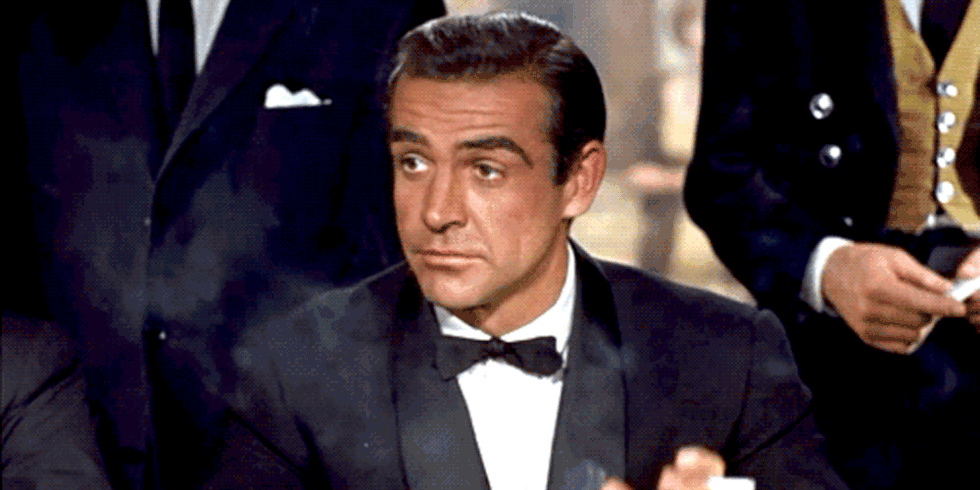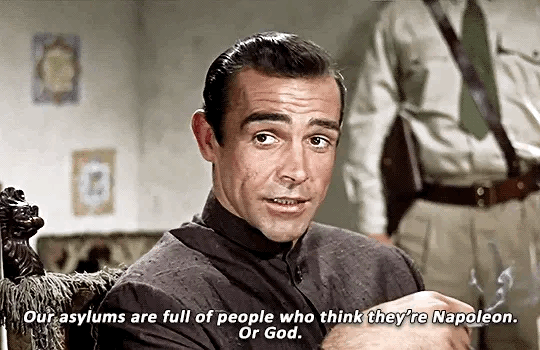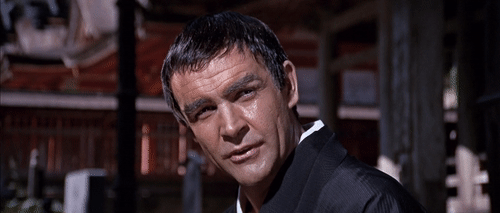When you think of a spy, you think of James Bond. And when you think of James Bond, you more than likely think of Sean Connery.
I would say “Poor Ian Fleming”, but frankly Fleming owes the longevity and popularity of his most famous literary creation to the Edinburgh-born bodybuilder with sexual charisma oozing from his 1.88m frame.
Fleming probably realised that too, despite his initial reserves at Connery’s casting. The “overgrown stunt man” didn’t fit his own vision of Commander Bond CMG RNVR. It was producer Albert R Broccoli’s wife Dana who realised Connery’s sex appeal was what the character needed.
But after seeing Connery in Dr No, Fleming wrote the actor’s Scottish heritage into the character’s backstory. Bond now had a Scottish father, from Glencoe. You Only Live Twice, the next novel published after Dr No’s cinematic debut, also gave Bond a sense of humour. That had not been a feature of the novels, but the devilishly charming Connery couldn’t help but bring it to the screen.
(Fun fact, I attribute at least some of this humour to Johanna Harwood, one of the few women to have a screenwriting credit on a Bond film. Director Terence Young described her as a script doctor, who “helped put elements more in tune with a British character”. Harwood had been producer Harry Saltzman’s secretary and reader in the late 1950s, and had even written a spoof James Bond short story called Some Are Born Great, in which a high stakes card game is revealed to be a game of Snap between a young Bond and his nanny. You tell me this woman didn’t have the cheeky chops to liven up Fleming’s thug.)
Connery’s roughness was refined by Dr No director Terence Young, who took the then 32-year-old to his own barber, made him sleep in tailored suits until they felt like a second skin, and introduced him to the right casinos, restaurants and women in London.
Despite this crash course in society’s upper crust, Connery’s Bond retained a meaty brutishness, as evidenced by the hard set of his jaw, the way he paced, the way his fingers grasped his hand-crafted Morland’s triple-banded cigarettes.
Less cloak-and-dagger, more smoke-and-swagger.
Connery’s charm is so memorable we don’t even notice the continuity error with his cigarette - we see him light it, then put his hand down, but when the camera pans back to his face the cigarette is back in his mouth. But who cares? We don’t watch Connery in the minute. We watch him as a whole; we drink in the whole experience of Connery’s Bond as easily as he knocks back a vodka martini.
The charm also makes us forget how coldly terrifying Connery could be when Bond was doing the dirty work of a secret agent. In Dr No, he dispatches the traitorous Professor Dent with considerably less emotion than one would brush a fly from one’s face.
But Connery also showed Bond’s delight in his chosen career, particularly the lure of the chase, the thrill of pursuit.
A favourite sequence from 1964’s Goldfinger, still one of the best in the franchise’s history, has Bond tailing the odd millionaire Auric Goldfinger from a safe distance courtesy of a tracking device.
When an attractive woman speeds ahead of him, his mood changes gear just as he shifts the stick, his hunting instinct switched on and ready to pursue his prey. But he remembers the mission and tells himself begrudgingly “Discipline, 007, discipline”.
Once the woman shoots and missed Goldfinger with a rifle, the rules change. The woman is now a part of his mission, and Bond is entitled to chase her down. He may be driving his famous Aston Martin, but Connery is all jaguar, his dark eyes flashing with delight as he engages in his favourite kind of foreplay - fast and full of gadgets.
There were missteps along the way, such as Connery’s strangely disengaged performance through much of You Only Live Twice, which despite having the first appearance of Blofeld, production designer Ken Adam’s wild volcano lair, and a spaceship that eats other spaceships, also had Bond going, err, “deep undercover” as a Japanese fisherman in yellowface that manages to be both really terrible and hardly noticeable.
So confused, Sean. We’re so confused.
And yes, his Bond slapped women. It’s always a reckoning to be reckoned with whenever we rewatch the early Bond movies. I’m comfortable enough in my feminism - and can acknowledge my bias towards these films enough - to know that these were movies of a time when violence against women was depicted more readily, particularly in stories about spies, schemes, capers and world domination, because violence against women was accepted more readily.
The same goes for the sexism - exchanges like this from Goldfinger make me both laugh with demented glee and cringe with horror at the audacity.
Of course the professional and the personal are different things, but it should be acknowledged that Connery’s ex-wife Diane Cilento wrote in her autobiography of being hit by him during their 11-year marriage, which spanned his time as Bond. Connery also infamously advocated that slapping women was understandable in many circumstances, comments which he apparently rejected in his later years, but of course remain unacceptable.
It is a reminder that no life is pure, and each individual will decide in their own heart how and why they want to separate a person’s professional output from their character or actions.
Connery left Bond in 1967 at odds with the producers, but returned in 1971 after George Lazenby dipped out of a second film and producers agreed to Connery’s demand for a $1 million salary to do Diamonds Are Forever. Only a decade earlier, the entire production budget of Dr No was $1 million. The franchise had soared to huge box office receipts in the intervening years, and Connery knew this. He took the money and invested it in a fund to pay for education for Scottish artists.
Connery had been receiving follicular assistance since the very beginning of his run as Bond, but it was Diamonds Are Forever that really made you notice it. The film is an odd mish-mash of parts, but remains a Bond film that I’ll happily rewatch for the sheer crazy fun. Come on, the dang thing has a moon buggy chase.
Connery’s fake hair only got worse in his quirky return to the role in the non-Eon film Never Say Never Again, a remake of Thunderball helmed by one of that film’s writers, and carrier of one of the world’s longest grudges, Kevin McClory.
Never Say Never Again is not the Bond film anyone should race to watch, but clips of Connery with Barbara Carrera’s show-stealing Fatima Blush are hilarious. Her death, which follows her narcissistic demand that Bond sign an oath that she was the best lover he’d ever had, is a marvel.
Connery seemed to ditch the hairpieces after Never Say Never Again, and perhaps that was key to the storied second half of his career, in which he seemed to embody the maxim that age and treachery will defeat youth and skill.
Beyond his Oscar-winning turn in The Untouchables, he delighted fantasy fans with Highlander (and perhaps for all the wrong reasons, Zardoz); joined another famous franchise as Harrison Ford’s Dad in Indiana Jones and the Last Crusade; did a nice line in thrillers such as The Hunt for Red October, The Russia House, Rising Sun and Entrapment); and even toyed with the concept of an older Bond in Michael Bay’s The Rock.
And of course for me, there is always his uncredited performance as King Richard the Lionheart in one of my most treasured movies, Robin Hood: Prince of Thieves.
In these roles, as in Bond, Connery’s lisping Scottish - emphasis on the “ish” - accent was made for loving imitation and parody. A Connery impression is so ubiquitous, lost tribes of the Amazon who’ve barely encountered Western civilisation would probably still do a decent “Greetingsh, Mish Moneypenny”.
Connery retired from acting in 2003 after the disappointing reaction to The League of Extraordinary Gentlemen film adaptation.
Clearly his views on showbusiness had changed since he was awarded the Cecil B. DeMille award at the 1996 Golden Globes, and which he accepted by saying “I promise to do everything I can to deserve it - except retire.”
It’s worth watching the whole speech, as Connery talks about that famous acc-shent and even makes a cracker of a Bond pun near the end. Above all you’ll see that dashing charm still rolling off his person as much as those “r”s roll off his tongue.
I find it endearing that this proud Scotsman died in his chosen retirement home of Nassau in the Bahamas. He filmed there during Thunderball in the 60s and Never Say Never Again in the 80s, and obviously developed an attachment to the place in a similar vein to Ian Fleming’s own connection with Jamaica.
His death was not wholly surprising, given he hadn’t been seen in public since attending the US Open tennis tournament in 2017 and turned 90 in the middle of this year.
But it’s still the passing of not just the man, but of an era and a style that he represented. It’s not like I actually want to live in the 60s, real or filtered through a glamorous film lens. But Connery as Bond makes it so attractive, it’s nice to take a nostalgic dip now and then.
Bond producer Michael G Wilson has said he hopes wherever Connery is, that there’s a golf course. I do not find golf an appealing sport, but I can watch Bond play Goldfinger without ever getting bored. For a spy movie famous for its ejector seat, woman painted gold, hat-throwing henchman and plot to nuke Fort Knox, Goldfinger also contains a 7 minute golf game sequence. That would never happen now, but Connery’s devilish delight in torturing his foe is palpably addictive.
Sean Connerycreated such an iconic character that every actor to follow in his polished, wing-tipped footprints has been compared to him. His DNA remains as tightly woven with the James Bond character as much as Ian Fleming’s.
It is an exceptional achievement.
Vale.


